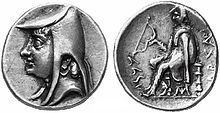Dynasty Arsacid dynasty Died 211 BC Successor Arsaces II of Parthia | Name Arsaces of House Parthian Empire Siblings Tiridates I of Parthia | |
 | ||
Reign ca. 250 BC to either 246 BC or 211 BC People also search for Tiridates I of Parthia, Andragoras, Georgi Todorov | ||
Arsaces I (/ˈɑrsəsiːz/; Persian: ارشک Arshak, Greek: Ἀρσάκης,) was the founder of the Arsacid dynasty, and after whom all 30+ monarchs of the Arsacid empire officially named themselves. A celebrated descent from antiquity (the Bagratid "line") begins with Arsaces. Arsaces or Ashk has also given name to the city of Ashkabad.
Contents
Origin
The dates of Arsaces' birth and death are unknown, as is his real name. Most scholars now believe that Arsaces was a chief of the Parni, a Dahae tribe who conquered Parthia shortly before Diodotus’ revolt. It should be noted, however, that there is no agreement among classical sources regarding his origins, and doubt about the accuracy of classical and traditional sources on the matter. Moreover, even the most respected and/or frequently cited sources regarding Arsaces are later reiterations of classical sources, such as Arrian (i., preserved in Photius and Syncellus) and Strabo (xi.)
Rival theories about the origions of Arsaces and/or the Parni Dahae include:
Reign
In contrast, the circumstances of Arsaces' ascent to power are relatively well known. Around 250 BC, Andragoras, the governor of the Seleucid province of Parthia, proclaimed his independence from the Seleucid monarchs, and made his governorate an independent kingdom. At about the same time, Arsaces was elected leader of the Parni, an eastern Iranian tribe. With the Parni, Arsaces seized Astauene (or Astabene), i.e., northern Parthia. Andragoras was killed during his attempts to recover it, which left the Parni in control over the rest of Parthia as well. A recovery expedition by the Seleucids under Seleucus II did not succeed, and Arsaces and the Parni succeeded in holding Parthia proper during Arsaces' lifetime. (Arsaces II lost it in 209 BC to Antiochus III, to whom the Arsacids became vassals for the next 25 years).
The line of succession is unclear, since his successors adopted the name Arsaces as well, making it difficult to distinguish them from the founder of the dynasty. From legend and secondary accounts, it seems that—at least from 246 BC onwards—Arsaces' brother Tiridates I either ruled in Arsaces' name or co-ruled with him. Then, after 211 BC, when another Arsaces is seen on coinage, either the brother ruled as Arsaces II, or Arsaces II was Arsaces' son (or nephew). Other combinations, e.g. that Tiridates killed his brother (as said by the later Arrian), have also been suggested.
Arsaces issued coins from silver drachmas to copper dikhakloi. All issues bear some similarity in style to the Seleucid pieces of the same time, although the headdress on the Parthian coinage is notably different. The commonest inscription is ΑΡΣΑΚΟΥ ΑΥΤΟΚΡΑΤΟΡΟΣ, translating as Arsaces the Autocrat, however there are many variations on this.
